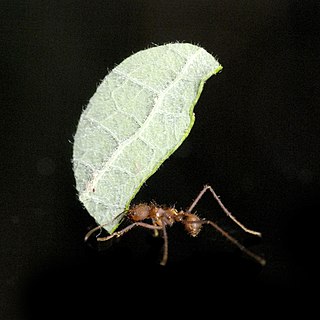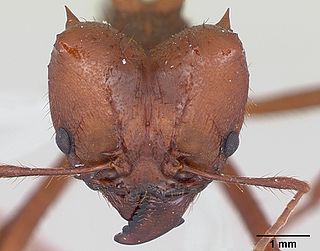This is a list of leafcutter ants , comprising 42 species from two genera: Atta and Acromyrmex .
| Species | Image | Common name | Distribution |
|---|---|---|---|
| Atta bisphaerica | |||
| Atta capiguara | |||
| Atta cephalotes |  | ||
| Atta colombica |  | Guatemala to Colombia, [1] Costa Rica | |
| Atta insularis |  | Occurs only in Cuba | |
| Atta laevigata |  | Hormiga culona, bachaco | from Colombia to Paraguay |
| Atta mexicana |  | Mexico crossing into Arizona | |
| Atta opaciceps | |||
| Atta robusta | |||
| Atta saltensis |  | ||
| Atta sexdens |  | southern United States to northern Argentina | |
| Atta silvai | |||
| Atta texana |  | Town ant, parasol ant, fungus ant, Texas leafcutter ant, cut ant, night ant | Texas, Louisiana, northeastern states of Mexico |
| Atta vollenweideri |  | ||
| Acromyrmex ameliae | southern Brazil | ||
| Acromyrmex ambiguus | Quenquém-preto-brilhante | Brazil, Paraguay, Uruguay | |
| Acromyrmex aspersus | Quenquém-rajada | southern Brazil and Peru | |
| Acromyrmex balzani |  | eastern Paraguay and southern Brazil | |
| Acromyrmex coronatus |  | Quenquém-de-árvore | Guatemala to Brazil and Ecuador |
| Acromyrmex crassispinus |  | Quenquém-de-cisco | throughout South America, especially in Argentina and Paraguay |
| Acromyrmex diasi | Quenquém-mirime, formiga-carregadeira | Brazil | |
| Acromyrmex disciger | Quenquém-mirime, formiga-carregadeira | Paraguay | |
| Acromyrmex fracticornis |  | southern Brazil, Paraguay, and northern Argentina | |
| Acromyrmex heyeri |  | Formiga-de-monte-vermelha | Paraguay, Argentina, Brazil, and Uruguay |
| Acromyrmex hispidus | Formiga-mineira (A. h. fallax), quenquém-de-cisco-da-Amazônia | southern Brazil and Bolivia | |
| Acromyrmex hystrix | Quenquém-de-cisco-da-Amazônia | Amazon [2] and Ecuador. [3] | |
| Acromyrmex landolti | Boca-de-cisco (A. l. balzani), formiga rapa-rapa (A. l. balzani), formiga-rapa (A. l. balzani), formiga meia-lua (A. l. balzani), formiga-mineira (A. l. fracticornis, A. l. landolti), formiga-mineira-vermelha (A. l. fracticornis, A. l. landolti) | ||
| Acromyrmex laticeps | Formiga-mineira (A. l. laticeps), formiga-mineira-vermelha (A. l. laticeps), quenquém-campeira (A. l. migrosetosus) | ||
| Acromyrmex lobicornis | Quenquém-de-monte-preta | ||
| Acromyrmex lundii |  | Hormigas jardineras, hormiga negra, formiga-mineira (A. l. pubescens), formiga-mineira-preta, quenquém-mineira (A. l. carli, A. l. lundi); Quenquém mineira-preta (A. l. carli, A. l. lundi) | Brazil, northern Argentina, and Paraguay |
| Acromyrmex mesopotamicus | |||
| Acromyrmex niger |  | Carieira, quenquém-mineira-da-Amazônia | Brazil, Paraguay |
| Acromyrmex nigrosetosus |  | ||
| Acromyrmex nobilis | Carieira, quenquém-mineira-da-Amazônia | ||
| Acromyrmex octospinosus |  | Bachaco sabanero, carieira, quenquém-mineira-da-Amazônia | southern Mexico to Panama, across northern South America in Venezuela |
| Acromyrmex pulvereus | |||
| Acromyrmex rugosus |  | Formiga-quiçaçá (A. r. rochai), saúva (A. r. rugosus), formiga-lavradeira (A. r. rugosus), formiga-mulatinha (A. r. rugosus) | |
| Acromyrmex silvestrii | |||
| Acromyrmex striatus |  | Formiga-de-rodeio, formiga-de-eira | |
| Acromyrmex subterraneus |  | Quenquém-de-cisco-graúda (A. s. bruneus), quenquém-caiapó-capixaba (A. s. molestans), caiapó (A. s. subterraneus) | |
| Acromyrmex versicolor |  | ||
| Acromyrmex volcanus |














